Updated on August 5th 2024
Here is a list of Japanese food glossary in alphabetical order. For your convenience, we have gathered 16 Japanese foods and dishes with photos all on one page. We’ll be adding more to the list as we go, so please come back to check the page from time to time.
Aojiso (青じそ)
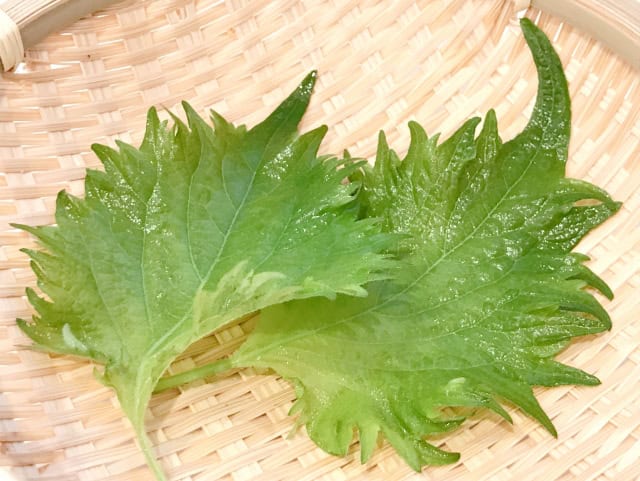
Aojiso (青じそ): Green Shiso
Green shiso is a Japanese herb which belongs to the mint family and it has a unique flavour. In Japanese cuisine, Aojiso is commonly used as a garnish for sashimi and sushi as well as a topping for noddle dishes including ramen noodles. Non-oil Aojiso dressing made with green shiso leaves is very popular in Japan for salad, tofu and noodles. Green shiso leaves can also be steamed, sautéed, or even deep-fried as vegetable tempura. You can find more info in our Shiso article.
Fukujin-zuke (福神漬け)
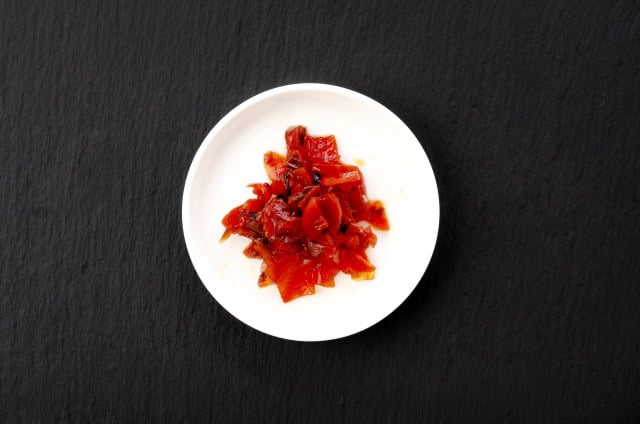
Fukujin-zuke (福神漬け): Sweet and Sour Japanese Pickles
Fukujinzuke is often eaten along with Japanese curry. It’s made from finely chopped or sliced vegetables such as daikon Japanese radish, aubergine, lotus root and cucumber which are salted and pickled in soy sauce, vinegar and sugar. Mirin (sweet cooking wine), sake and ginger can be added to the mixture. Shiitake mushrooms, goma sesame and shiso herb seeds can also be included to make Fukujinzuke.
Gyudon (牛丼)
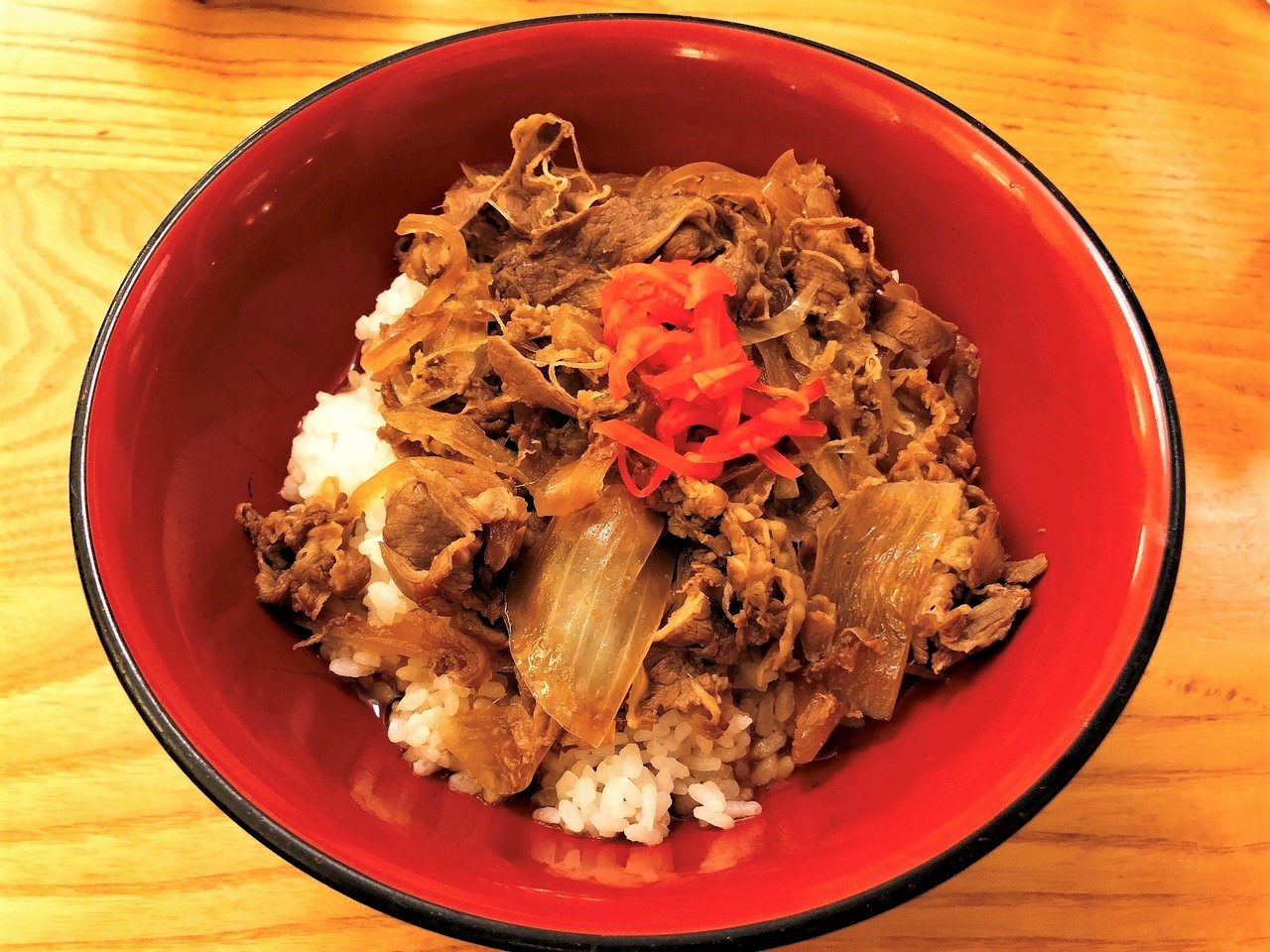
Gyudon (牛丼): Beef Rice Bowl
Gyu means beef in Japanese while “don” is short for rice bowl. Put them together and you get a gyudon – a hearty rice bowl topped with thinly sliced beef and onion simmered in soy sauce, sake, sugar and/or mirin (sweet cooking wine). It’s usually garnished with beni shoga (Japanese red pickled ginger).
Hiyashi Chuka (冷やし中華)

Hiyashi Chuka (冷やし中華): Chilled Ramen Noodles
Hiyashi Chuka is cold ramen topped with some meat and summer vegetables. A soup-typed tare sauce (either tangy soy-based or sesame-based) is poured over the chilled ramen noodles. Mayonnaise and/or Japanese karashi mustard can be put on the side. The popular toppings include shredded ham, fried egg, cucumber, wakame seaweed, tomato and boiled shrimp. This is one of the must-eat summer foods in Japan.
Hiya-yakko (冷奴)
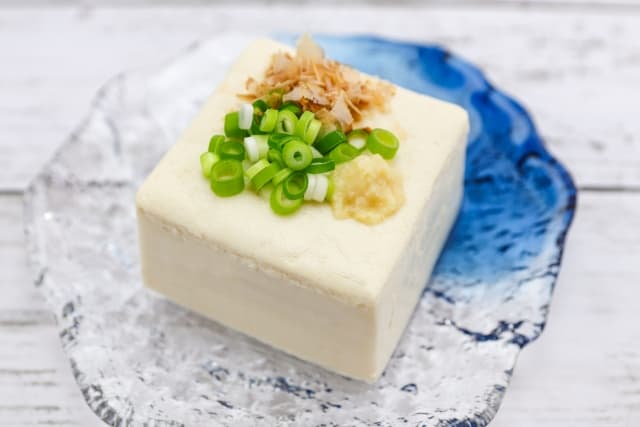
Hiya-yakko (冷奴): Chilled Silken Tofu
Hiya-yakko is a cold tofu dish that is generally topped with chopped green onions, grated ginger and katsuobushi (dried bonito flakes), but it can be made in a variety of ways with different toppings and sauces. This super-easy and quick to make, yet very refreshing dish, is loved by many Japanese to make and eat at home during the hot summer months in Japan.
Kakiage (かき揚げ)
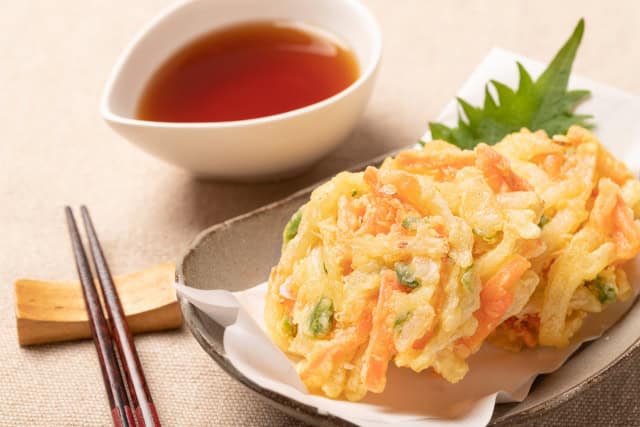
Kakiage (かき揚げ): Mixed-Vegetable Tempura
Thinly cut vegetables such as carrots, onions and spring onions are mixed with tempura batter, and then deep-fried. Chopped mitsuba (Japanese parsley) and dried or fresh shrimp can be added to the mixture as well. It’s usually served with tentsuyu (tempura dipping sauce) and grated ginger and/or daikon (Japanese radish).
Kamaboko (蒲鉾・かまぼこ)
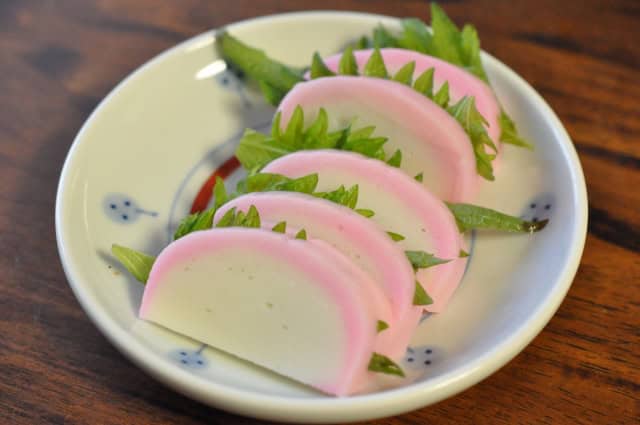
Kamaboko (蒲鉾・かまぼこ): Japanese Fish Cake
Kamaboko is a processed seafood product and comes in red or white. You’ll quite often see sliced kamaboko placed as toppings on Japanese udon and soba noodles. Sliced kamaboko can be eaten dipped in soy sauce with a little bit of wasabi (Japanese horseradish) as well.
Karaage (唐揚げ)

Karaage (唐揚げ) : Japanese-style Friend Chicken
Karaage usually means Chicken Karaage (Tori no Karaage) even though seafood and meat can be deep fried in hot oil to make Karaage. In Japan, generally boneless chicken thigh is used, but Karaage can be made from the breast part as well. The chicken is cut into bite-size pieces and marinated in soy sauce, sake, ginger, and garlic, then coated in potato starch before being deep-fried.
Mochi (もち)
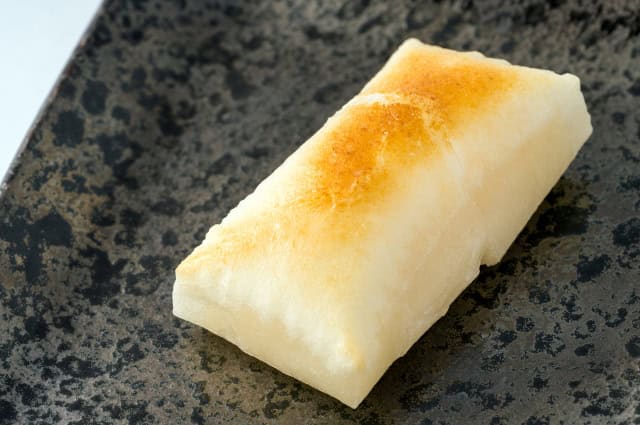
Mochi (もち): Japanese Rice Cake
Mochi is a type of traditional Japanese rice cake that is made by pounding steamed sticky rice grains into a paste and molding them into shape. Mochi can be eaten as a savoury dish or turned into a variety of delicious Wagashi Japanese sweets.
Okonomiyaki (お好み焼き)
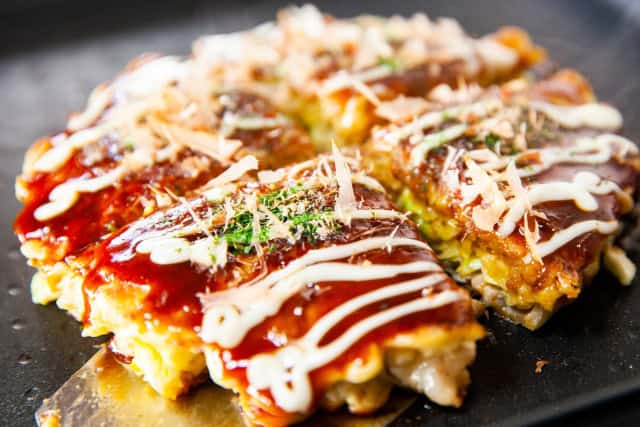
Okonomiyaki (お好み焼き): Japanese Savoury Pancake
Okonomiyaki is made with flour, eggs, shredded cabbage, dashi stock and your choice of meat or seafood such as sliced pork belly, bacon, squid or shrimp. Okonomiyaki is typically topped with katsuobushi (bonito flakes), aonori (dried green nori seaweed flakes), and beni shoga (Japanese red pickled ginger), along with very tasty Okonomiyaki sauce and mayonnaise. Chopped green onions, beni shoga and tenkasu (tempura crumbs) can be added to the Okonomiyaki batter mixture before cooking.
Omu-rice (オムライス)

Omu-rice (オムライス): Japanese Rice Omelette
Omurice or omu-rice is a thin layer of omelette wrapped around ketchup flavoured fried rice with chicken or sausage. It’s usually topped with ketchup as well. Omurice is an extremely popular dish among Japanese people and especially loved by children.
Onigiri (おにぎり) / Omusubi (おむすび)
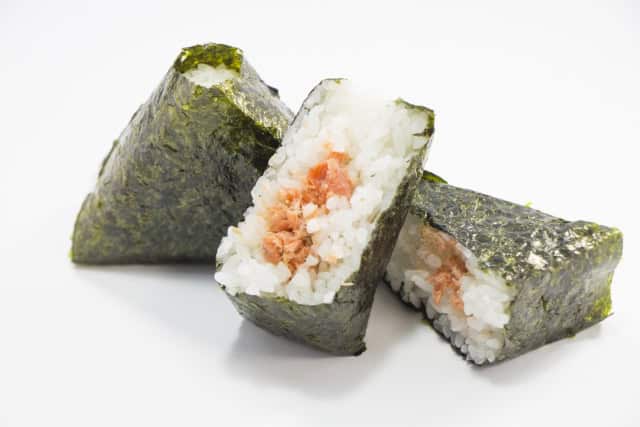
Onigiri (おにぎり) / Omusubi (おむすび): Japanese Rice Balls
Onigiri / Omusubi Rice balls are cooked rice that are formed into triangle, round, or cylinder shapes and filled with salted salmon, ume/umeboshi (Japanese pickled plum) or okaka (dried bonito flakes with soy sauce). Onigiri is typically wrapped in a nori seaweed sheet but can be made without it. The other popular fillings include tuna mayo (tinned tuna with mayonnaise) and tarako (salted cod roe).
Somen (そうめん)
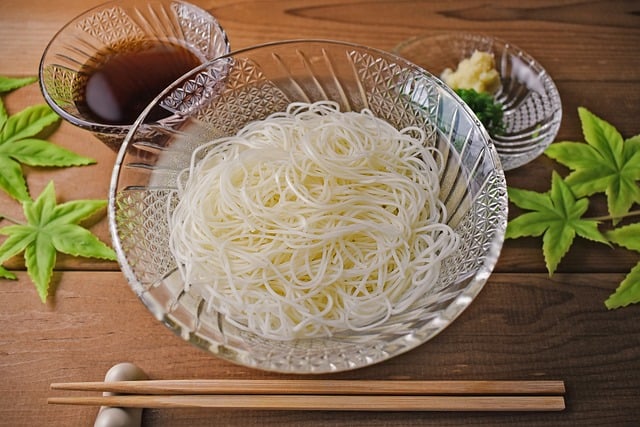
Somen (そうめん): Japanese Thin White Noodles
Somen noodles are a thin white vermicelli-type of wheat noodles. Hiyashi Somen (Chilled Somen) is one of the most eaten summer foods in Japan and usually served with Tsuyu dipping sauce, chopped green onions and grated ginger.
Takoyaki (たこ焼き)
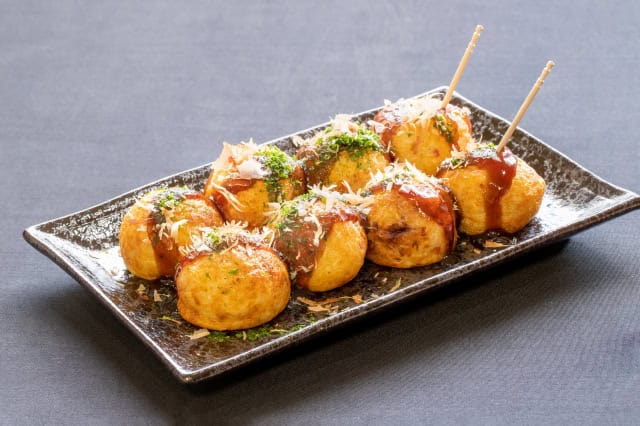
Takoyaki (たこ焼き): Grilled Octopus-Filled Balls
A savoury bite-sized snack of grilled balls of batter mixture made with flour, egg, dashi stock, and small pieces of octopus. Chopped beni shoga (Japanese red pickled ginger), green onions, and tempura flakes can be added to the mixture. A Takoyaki pan or Takoyaki maker is used to cook and make the batter mixture into ball-shape. Before serving, Takoyaki sauce, a thick sweet brown sauce, is drizzled over as well as mayonnaise and finally the Takoyaki are usually sprinkled with aonori (dried green nori seaweed flakes) and katsuobushi (dried bonito flakes).
Tonkotsu Ramen (豚骨ラーメン) / Hakata Tonkotsu Ramen (博多豚骨ラーメン)
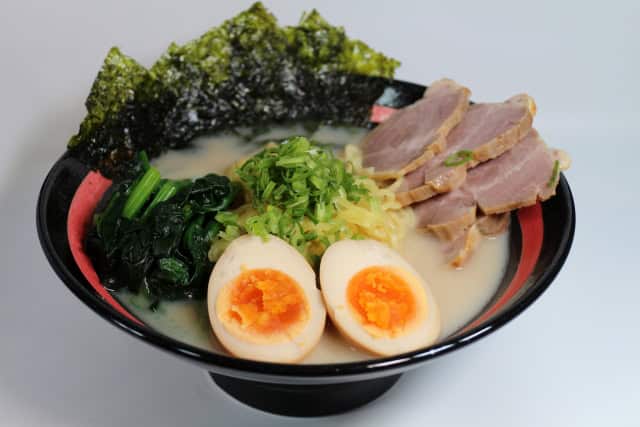
Tonkotsu Ramen (豚骨ラーメン) / Hakata Tonkotsu Ramen (博多豚骨ラーメン): Pork Bone Ramen
Tonkotsu Ramen or Hakata (Tonkotsu) Ramen is a style of ramen from Fukuoka (south-west of Japan) and made of a rich pork broth, fresh ramen noodles, and soft-yolk eggs. It often comes with toppings such as sliced tender Chashu pork belly, Ajitama (boiled egg marinated in a sauce), Nori seaweed sheet, Kikurage (wood ear mushrooms) and chopped spring onions.
Unagi no Kabayaki (うなぎの蒲焼)
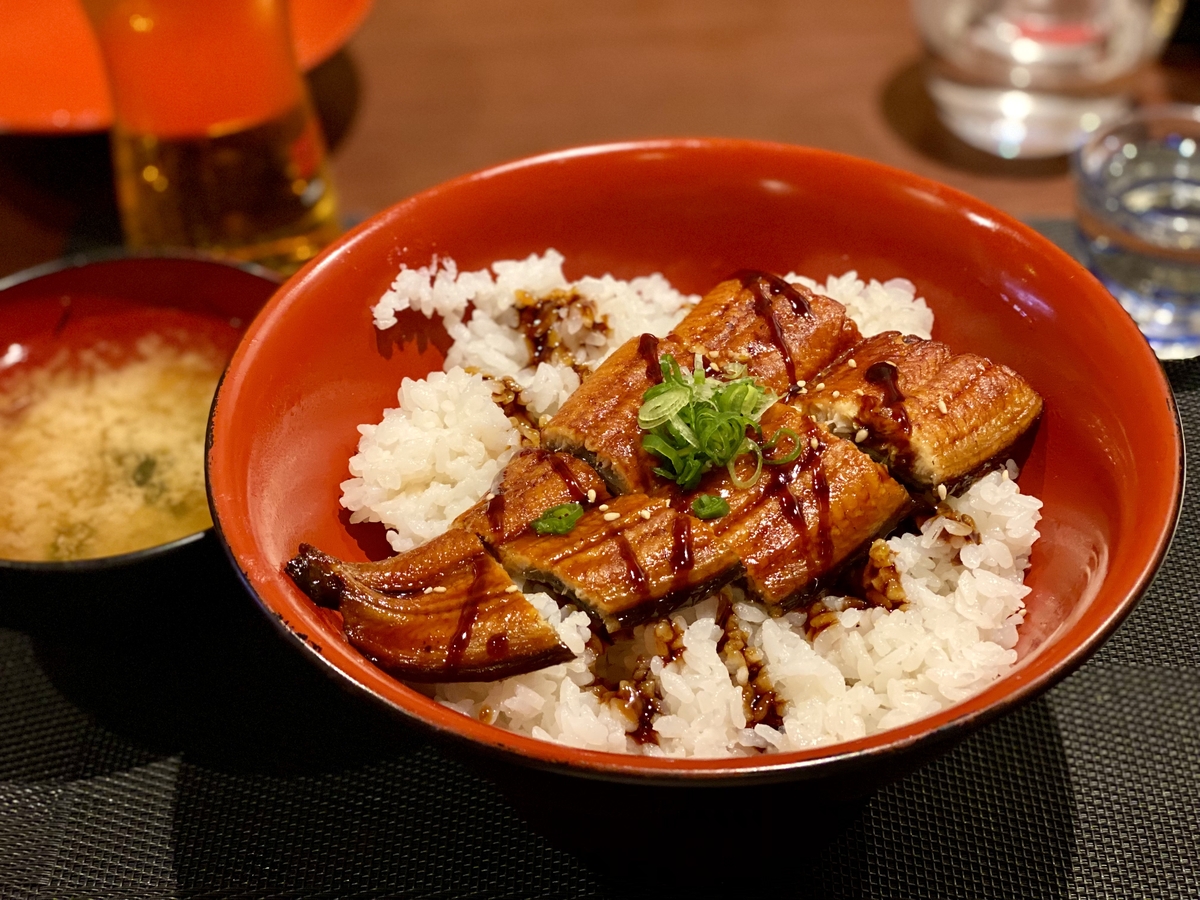
Unagi no Kabayaki (うなぎの蒲焼): Grilled Eel
Unagi no Kabayaki is grilled eel that is cooked on a grill after marinated in a sweet soy based sauce and glazed with the tare sauce during cooking. It’s usually served sliced and over a bowl of cooked rice with a thick sweet sauce drizzled on top. Sansho pepper (a spice with citrusy flavour) is typically sprinkled over grilled eel in Japan.
If you’re seeking for more information on Japanese Foods and Supermarkets, check out our Best Japanese Supermarket in London. For those who are interested in Japanese Culture, do explore our Culture section. Or you can head to our Instagram account for posts of fantastic festivals, events, and restaurants we’ve been to.

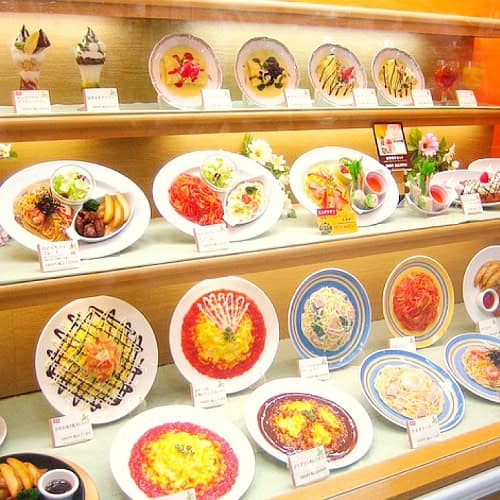

6 comments
[…] organic chicken. It was soft and succulent and definitely a highlight. Meanwhile the Naruto / Kamaboko slice and crunchy Menma bamboo shoots provided a variety of textures, however the crisp fresh […]
[…] the dishes arrived though – both were fantastic, although I’m more of a fan of their Karaage if I had to pick one over the […]
[…] Hakata Tonkotsu which is meant to be richer. The gyozas were crispy on top and a good size. The Takoyaki could have had a bit more tako (octopus) in it but I understand it’s not to everyone’s […]
Nice! I didn’t know Tonkotsu originated from Fukuoka. It’s definitely an art the way they make ramen in Japan. Thanks for the glossary! It’s nice to have.
[…] bakery goods too. This includes Shokupan milk bread, Matcha chocolate croissants, nostalgic Melon pan, and recently fruit […]
[…] food section is extensive and you can get staples like Okonomiyaki flour, a solid selection of noodles including vegan friendly ramen, and a fantastic range of […]
Comments are closed.